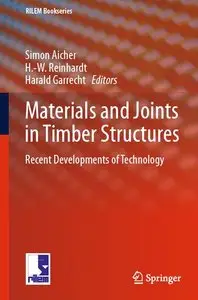Materials and Joints in Timber Structures: Recent Developments of Technology (RILEM Bookseries) by Simon Aicher, H. -W. Reinhardt and Harald Garrecht
English | 2013 | ISBN: 9400778104 | 600 pages | PDF | 48 MB
English | 2013 | ISBN: 9400778104 | 600 pages | PDF | 48 MB
This book contains the contributions from the RILEM International Symposium on Materials and Joints in Timber Structures that was held in Stuttgart, Germany from October 8 to 10, 2013. It covers recent developments in the materials and the joints used in modern timber structures.
Regarding basic wooden materials, the contributions highlight the widened spectrum of products comprising cross-laminated timber, glulam and LVL from hardwoods and block glued elements. Timber concrete compounds, cement bonded wood composites and innovative light-weight constructions represent increasingly employed alternatives for floors, bridges and facades. With regard to jointing technologies, considerable advances in both mechanical connections and glued joints are presented. Self-tapping screws have created unprecedented options for reliable, strong as well as ductile joints and reinforcement technologies. Regarding adhesives, which constitute the basis of the jointing/laminating technology of modern timber products, extended options for tailor-made bonding solutions have to be stated. Apart from melamine-urea and phenolic-resorcinol adhesives, one-component-polyurethanes, emulsion isocyanate polymers and epoxies offer a wide range of possibilities. The contributions dealing with experimental and numerical investigations on static, cyclic and seismic behavior of structures clearly reveal the enhanced potential of modern timber construction for reliable and sustainable buildings and bridges of the new millennium.
The book is structured in nine thematic areas, being
I) Structures
II) Mechanical Connections
III) Glued Joints and Adhesives
IV) Timber and Concrete/Cement/Polymer Composites
V) Cyclic, Seismic Behavior
VI) Hardwood, Modified Wood and Bamboo
VII) Cross-Laminated Timber
VIII) Properties and Testing of Wood
IX) Glulam



